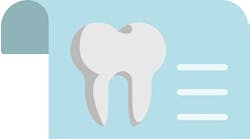We ask two experts the same questionon a complex issue.
Question:
What are the most critical numbers to consider when establishing the value of a practice?
John M. Cahill, MBA
Every professional practice appraiser could and would answer this question differently. In my opinion, there are several numbers that are critical in determining the value of a dental practice, and all are interrelated.
Certainly, the gross receipt numbers for the past several years will give you an indication as to the direction in which the practice is headed - increasing, decreasing, or flat-line indicators. Obviously, increasing numbers are going to reflect more favorably and reflect a higher value than either decreasing or flat-line numbers.
In my opinion, the next critical number ... even more important than revenues ... would be adjusted net profit (gross revenues less all true practice business expenses). Adjusted net profit reflects the real profit being generated from the practice. With this number, a buyer is able to justify the value and determine if he or she can afford to purchase the practice and pay not only debt service and personal expenses, but have a cushion to adjust for any margin of errors in the value price. Adjusted net profit is even more important than gross revenues, since this is the driving force essential in making a practice have value in the first place.
Two other numbers that are important in determining value are the number of active patients (patients seen in the last 18 to 24 months) and the number of new patients per month seen in the practice. These numbers give an appraiser, as well as a buyer, what they can expect from the practice if they are to purchase it. Without a reasonable and significant active patient base from which to draw, the value of a practice is adversely affected. Likewise, a practice that is not generating new patients to replace old patients is not as valuable as a practice that is seeing a healthy influx of new patients.
Tom Snyder, DMD, MBA
Apart from geographical location being the most critical factor that impacts the value of most dental practices, there are several other important numbers (metrics) that will impact a practice's value. First and foremost, net profit is the driving force affecting practice value. When you purchase a dental practice, you are purchasing the practice's historical cash flow, so the more profitable the practice, typically the higher the practice value.
Profit margins translate into good cash flow, thus allowing banks to fund practice acquisition loans and give the buyer a comfortable income. If the practice has a high overhead, typically above 70%, this usually has a negative impact on practice value. Oftentimes, high overhead is attributed to higher than average staff salaries and fringe benefits as well as occupancy costs (usually in major metropolitan areas).
Another important metric is the number of "active patients." An active patient is often defined as a patient having at least one recare visit within an 18-month period. For example, a practice with 800 active patients may often have a lower practice value than a practice with an active patient base of 1,500.
Another key metric, "new patients per month," tells a story about the practice's ability to generate growth.
Next, a strong recare program also enhances value for general practices. A ratio between 25% and 30% of total production is evidence that the practice has very good patient retention. A strong recare program is analogous to an annuity, providing predictable annual income.
Other numbers that have some merit in valuing a dental practice are the ratios relating to the age range of the patient base. This is particularly true when valuing family-based general practices. Is there a good dispersion of age ranges or are patients' ages skewed to an older age grouping? This metric may have implications for practice growth.
Finally, the clinical production mix may foretell a great deal about practice opportunity and potential. For example, are many clinical procedures of relatively low volume for the size of the patient base, implying many procedures being referred to area specialists? That most certainly may mean an enhanced revenue opportunity for a purchaser! Conversely, is there a high percentage of clinical services being provided in one area - for example, crown and bridge? This is often seen in practices with smaller patient bases and minimal new-patient inflow. This could be a predictor of a practice lacking growth potential. So when reviewing a practice valuation, understanding how these numbers relate can mean the difference between making a good or bad practice acquisition.
John M. Cahill, MBA, of Western Practice Sales/John M. Cahill Associates, has more than 40 years of experience in the dental industry, including all aspects of appraisal, sales, purchases, and buy-ins in connection with dental transitions. Cahill is an emeritus member of American Dental Sales, Inc., and can be reached at (855) 463-0101 or by email at [email protected].
Visit his website at westernpracticesales.com.
Tom Snyder, DMD, MBA, is the director of transition services for Henry Schein Professional Practice Transitions. He can be reached at (800) 988-5674 or [email protected].





